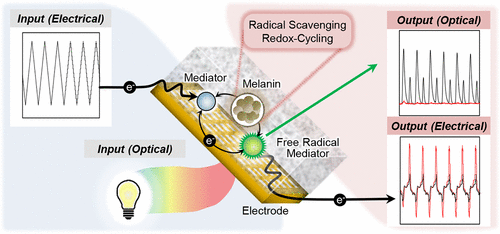当前位置:
X-MOL 学术
›
Biomacromolecules
›
论文详情
Our official English website, www.x-mol.net, welcomes your
feedback! (Note: you will need to create a separate account there.)
Spectroelectrochemical Reverse Engineering DemonstratesThat Melanin’s Redox and Radical Scavenging Activities Are Linked
Biomacromolecules ( IF 5.5 ) Pub Date : 2017-11-01 00:00:00 , DOI: 10.1021/acs.biomac.7b01166 Eunkyoung Kim 1, 2 , Mijeong Kang 1, 2 , Tanya Tschirhart 3 , Mackenzie Malo 4 , Ekaterina Dadachova 4 , Gaojuan Cao 5 , Jun-Jie Yin 5 , William E. Bentley 1, 2 , Zheng Wang 6 , Gregory F. Payne 1, 2
Biomacromolecules ( IF 5.5 ) Pub Date : 2017-11-01 00:00:00 , DOI: 10.1021/acs.biomac.7b01166 Eunkyoung Kim 1, 2 , Mijeong Kang 1, 2 , Tanya Tschirhart 3 , Mackenzie Malo 4 , Ekaterina Dadachova 4 , Gaojuan Cao 5 , Jun-Jie Yin 5 , William E. Bentley 1, 2 , Zheng Wang 6 , Gregory F. Payne 1, 2
Affiliation

|
Melanins are ubiquitous in nature but their biological activities and functions have been difficult to discern. Conventional approaches to determine material function start by resolving structure and then characterize relevant properties. These approaches have been less successful for melanins because of their complex structure and insolubility, and because their relevant properties are not readily characterized by conventional methods. Here, we report a novel spectroelectrochemical reverse engineering approach that focuses on redox and radical scavenging activities. In this method, the melanin is immobilized in a permeable hydrogel film adjacent to an electrode and this immobilized melanin is probed using diffusible mediators and complex electrical inputs. Response characteristics are measured using two modalities, electrochemical currents associated with the reaction of diffusible mediators, and optical absorbance associated with the presence of diffusible free radicals. Using this method, we observed that both Sepia and fungal melanins are redox active and can repeatedly exchange electrons to be switched between oxidized and reduced states. Further, we observed that these melanins can quench radicals either by donating or accepting electrons. Finally, we demonstrate that the melanins’ radical scavenging activities are dependent on their redox state such that a melanin must be reduced to have donatable electrons to quench oxidative free radicals, or must be oxidized to accept electrons from reductive free radicals. While the observation that melanin is redox-active is consistent with their well-accepted beneficial (radical-scavenging) and detrimental (pro-oxidant) activities, these observations may also support less well-accepted proposed functions for melanin in energy harvesting and redox communication.
中文翻译:

光谱电化学逆向工程表明黑色素的氧化还原和自由基清除活性之间存在联系
黑色素在自然界中无处不在,但它们的生物学活性和功能却很难辨别。确定材料功能的常规方法始于解析结构,然后表征相关特性。由于黑色素的复杂结构和不溶性,以及传统方法不容易表征其相关特性,因此这些方法对黑色素的成功率较低。在这里,我们报告了一种新颖的光谱电化学逆向工程方法,该方法侧重于氧化还原和自由基清除活性。在这种方法中,将黑色素固定在与电极相邻的可渗透水凝胶薄膜中,并使用可扩散介体和复杂的电输入来探测这种固定的黑色素。响应特性是通过两种方式测量的:与可扩散介质的反应相关的电化学电流,以及与可扩散自由基的存在相关的光吸收。使用这种方法,我们观察到棕褐色和真菌黑色素具有氧化还原活性,可以反复交换电子以在氧化态和还原态之间切换。此外,我们观察到这些黑色素可以通过给电子或接受电子来淬灭自由基。最后,我们证明了黑色素的自由基清除活性取决于它们的氧化还原状态,因此黑色素必须被还原以具有可供电的电子来猝灭氧化性自由基,或者必须被氧化以接受来自还原性自由基的电子。虽然关于黑色素具有氧化还原活性的观察结果与其公认的有益(自由基清除)和有害(促氧化剂)活性是一致的,但这些观察结果也可能支持不太广泛接受的提议的黑色素在能量收集和氧化还原沟通中的功能。
更新日期:2017-11-02
中文翻译:

光谱电化学逆向工程表明黑色素的氧化还原和自由基清除活性之间存在联系
黑色素在自然界中无处不在,但它们的生物学活性和功能却很难辨别。确定材料功能的常规方法始于解析结构,然后表征相关特性。由于黑色素的复杂结构和不溶性,以及传统方法不容易表征其相关特性,因此这些方法对黑色素的成功率较低。在这里,我们报告了一种新颖的光谱电化学逆向工程方法,该方法侧重于氧化还原和自由基清除活性。在这种方法中,将黑色素固定在与电极相邻的可渗透水凝胶薄膜中,并使用可扩散介体和复杂的电输入来探测这种固定的黑色素。响应特性是通过两种方式测量的:与可扩散介质的反应相关的电化学电流,以及与可扩散自由基的存在相关的光吸收。使用这种方法,我们观察到棕褐色和真菌黑色素具有氧化还原活性,可以反复交换电子以在氧化态和还原态之间切换。此外,我们观察到这些黑色素可以通过给电子或接受电子来淬灭自由基。最后,我们证明了黑色素的自由基清除活性取决于它们的氧化还原状态,因此黑色素必须被还原以具有可供电的电子来猝灭氧化性自由基,或者必须被氧化以接受来自还原性自由基的电子。虽然关于黑色素具有氧化还原活性的观察结果与其公认的有益(自由基清除)和有害(促氧化剂)活性是一致的,但这些观察结果也可能支持不太广泛接受的提议的黑色素在能量收集和氧化还原沟通中的功能。











































 京公网安备 11010802027423号
京公网安备 11010802027423号